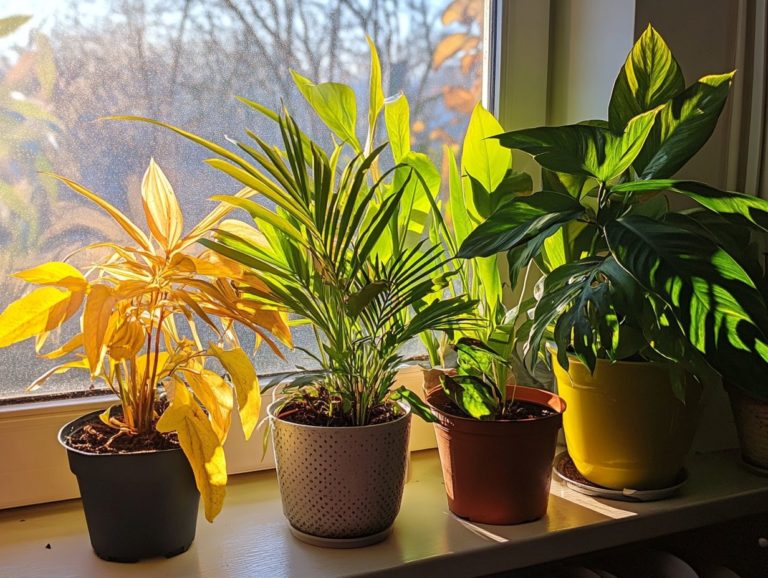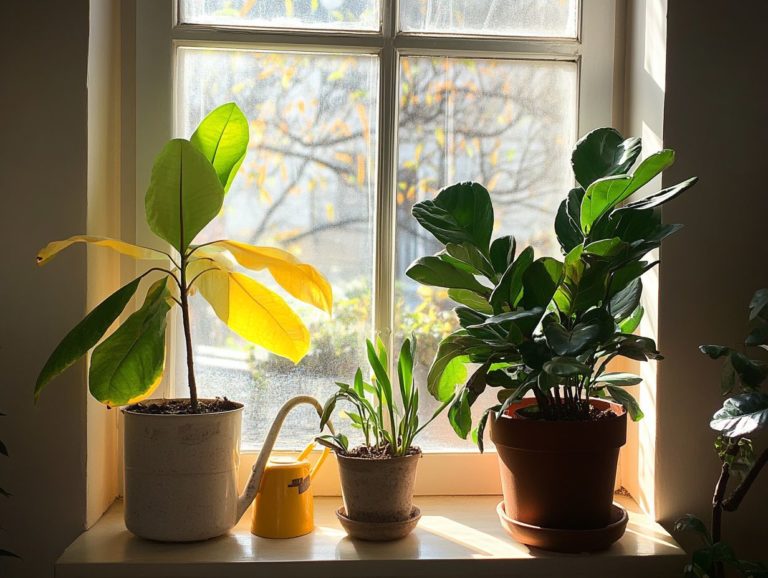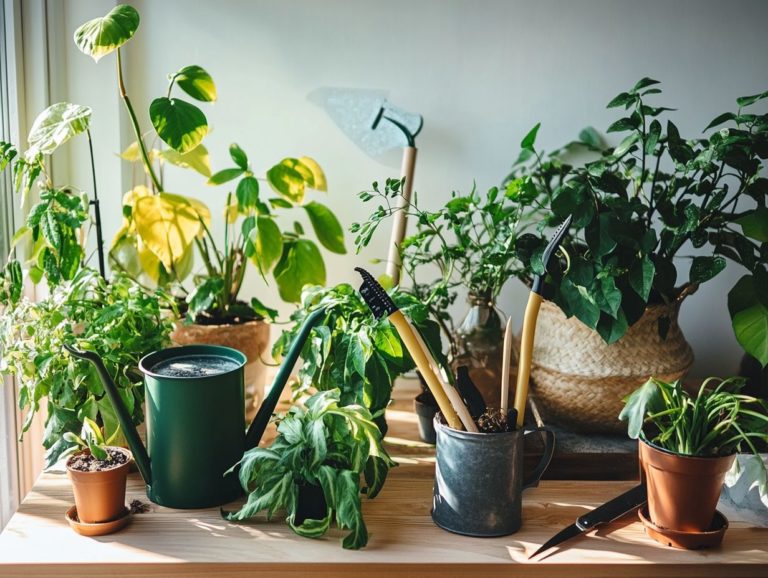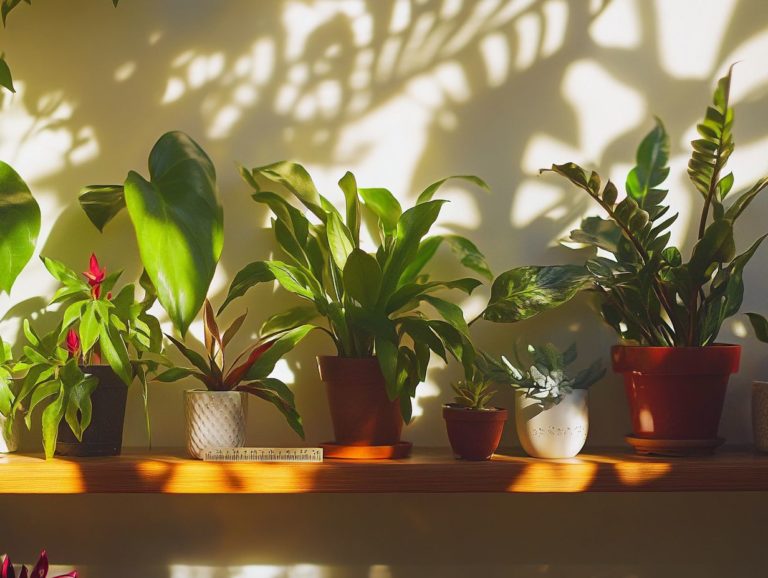Indoor Plant Problems: When to Seek Help
Indoor plants can infuse any space with vibrant life and tranquility, yet they come with their own challenges.
From spotting issues like brown leaves or wilting stems to knowing when it’s time to consult a professional, understanding what your plants need is key. This guide offers effective prevention strategies, pest management techniques, and tips for revitalizing struggling plants.
Whether you re a seasoned plant parent or just beginning your journey, you ll find valuable insights here to help you nurture your green companions with confidence.
Contents
- Key Takeaways:
- Common Indoor Plant Problems
- When to Seek Professional Help
- Preventing Indoor Plant Problems
- Dealing with Pests and Diseases
- Reviving a Dying Plant
- Frequently Asked Questions
- What are some common signs that my indoor plants need help?
- When should I seek professional help for my indoor plants?
- How can I tell if my indoor plant problems are normal or not?
- Can I save my dying indoor plant on my own?
- What are some common mistakes that can lead to indoor plant problems?
- Can indoor plant problems be prevented?
Key Takeaways:
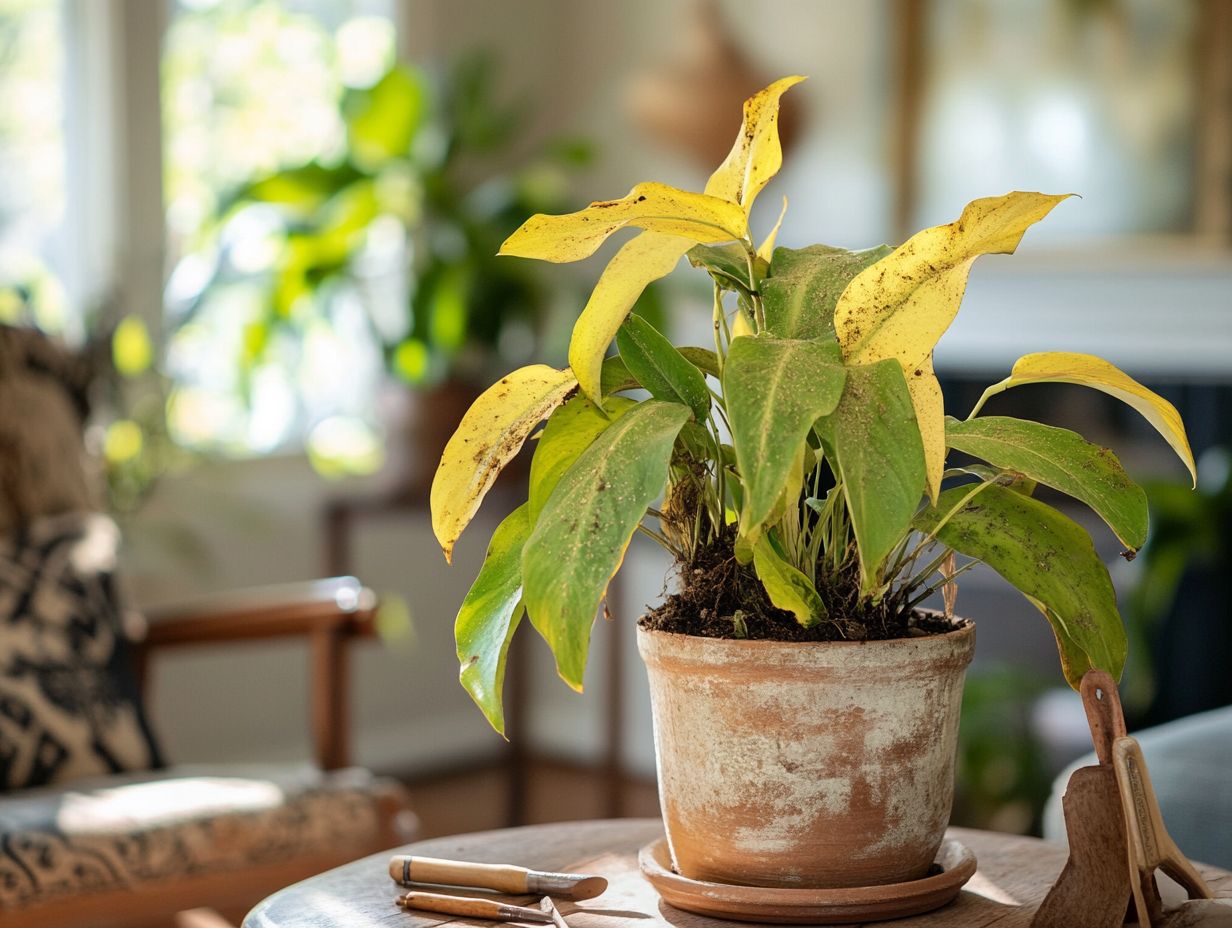
- Know how to identify and understand common indoor plant problems to effectively address them.
- Seek professional help when signs of plant distress are present, such as yellowing leaves or wilting.
- Prevent indoor plant problems by regularly maintaining healthy plants through proper watering, lighting, and fertilization.
Common Indoor Plant Problems
Indoor gardening can be a truly rewarding hobby! You might face challenges like yellowing leaves or pests like spider mites and pesky fungal diseases, all of which demand your attentive care for your houseplants to thrive.
Spotting these issues early helps keep your plants healthy. By understanding the specific light requirements, soil conditions, and humidity levels, you can significantly elevate your plant care routine.
With a proactive and informed approach, you have the power to combat potential plant diseases and nurture your indoor plants like a seasoned expert.
Identifying and Understanding Plant Issues
Identifying and understanding plant issues is crucial for maintaining healthy houseplants. Symptoms like yellowing leaves can signal a variety of problems, ranging from overwatering to pest infestations.
For instance, when you notice your leaves losing their vibrant green hue and turning yellow, it might indicate poor soil drainage or not enough nutrients. You can spot the early signs of root rot (a condition where roots decay due to excess moisture) by observing stunted growth and a foul odor wafting from the soil. Other symptoms, such as wilting or browning edges, often suggest inadequate humidity levels or potential pest troubles.
You can address these issues by evaluating your plant s environment. Ensure you re practicing proper watering techniques and providing adequate light conditions while keeping an eye on humidity levels.
By adjusting your watering schedule, enriching the soil with nutrients, or tackling pest control proactively, you can significantly boost the overall health of your houseplants.
When to Seek Professional Help
Recognizing when to seek professional help for houseplant issues is essential for any indoor gardening enthusiast. Certain plant diseases and pest infestations may require expert intervention to safeguard the health of your plants.
While many challenges can be tackled with careful attention, more complex problems like severe root rot or widespread pest infestations often call for the expertise of a professional. By understanding the signs of aging in indoor plants and identifying the specific challenges they face, you can act swiftly and effectively, ensuring the longevity of your cherished indoor greenery.
Signs that a Plant Needs Expert Attention

Certain signs will tell you when a plant might need some expert help. Look out for persistent yellowing leaves, drooping stems, and unwelcome guests like spider mites or aphids.
These indicators often reveal underlying issues, such as improper watering, nutrient deficiencies (lack of essential nutrients in the soil), or environmental stress. For example, if your plant is wilting, it might mean the roots are either drowning in water or parched. Meanwhile, those unusual leaf colors could be a cry for help from pests wreaking havoc on your plant’s health.
Recognizing these symptoms early is essential; addressing them quickly can prevent further damage and boost the chances of recovery. In many cases, turning to a professional for evaluation and treatment will ensure your plant gets the proper care it needs to flourish. Additionally, referring to a quick guide to common indoor plant issues can be incredibly helpful in identifying and solving problems efficiently.
Preventing Indoor Plant Problems
Preventing indoor plant issues starts with a care routine that includes a good understanding of watering schedules, light requirements, and soil conditions vital for your houseplants to thrive.
By establishing a consistent approach to plant care, you can effectively mitigate common challenges faced by indoor gardeners, such as yellowing leaves and root rot, which occurs when roots sit in too much water, while simultaneously enhancing the overall health and growth of your plants.
This proactive strategy involves monitoring humidity levels and adjusting your care as needed, ensuring that your indoor plants flourish beautifully in their environment.
Tips for Maintaining Healthy Plants
Maintaining healthy houseplants requires you to find the right balance among various factors, such as appropriate care, humidity levels, and a tailored watering routine for each species.
Understanding the unique needs of different plants is essential some flourish in moist environments while others thrive in drier soils. Regularly checking the moisture level can save you from the pitfalls of overwatering or underwatering; a simple finger test can serve as your trusty gauge.
To boost humidity, consider misting your plants or using a humidity tray, creating an ideal environment for tropical varieties that prefer a bit more moisture in the air.
Keep your plants away from cold windows or heating vents to protect them from sudden temperature shifts, helping them remain healthy and vibrant throughout the year.
Dealing with Pests and Diseases
Managing pests and diseases is essential in indoor gardening, as infestations and infections can swiftly threaten the well-being of your cherished houseplants.
By using pest control measures and learning to identify signs of spider mites or fungal diseases, you can protect your plants from significant harm.
Employing strategies like early detection, meticulous sanitation, and organic treatments will keep your indoor flora vibrant and thriving. Enjoy the beauty and benefits of indoor gardening, free from the stress of plant-related issues.
Effective Treatment and Prevention Strategies
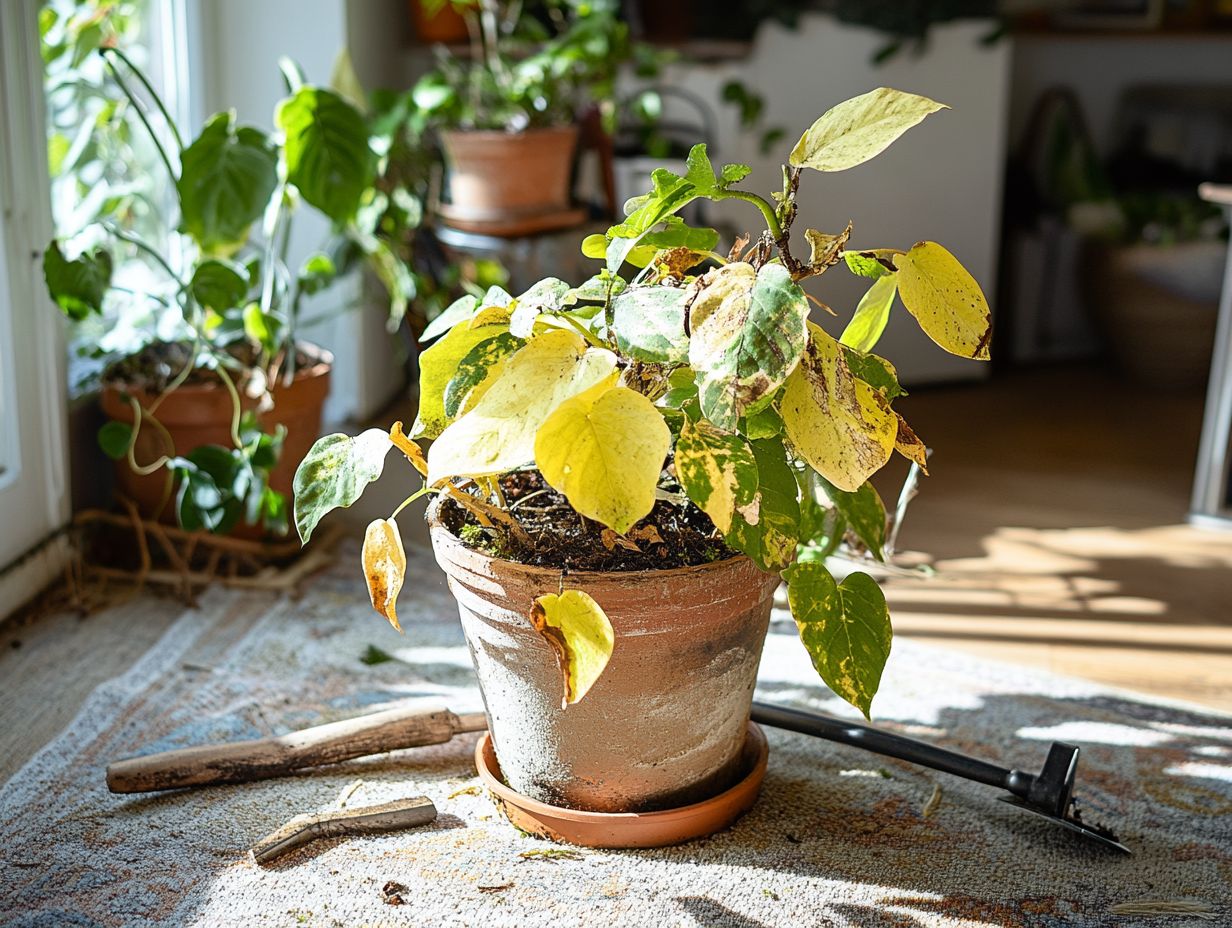
Effective treatment and prevention strategies for houseplant issues involve a variety of approaches, ranging from organic pest control methods to tackling root rot and fungal diseases.
By understanding the specific vulnerabilities of popular indoor plants, you can make informed choices about the best solutions. For example, neem oil is an outstanding organic pesticide that effectively fights off aphids and spider mites while remaining gentle on beneficial insects.
Introducing beneficial insects like ladybugs can also help create a natural balance in pest management.
When grappling with fungal problems, a simple concoction of baking soda and water can serve as an effective preventative spray against diseases like powdery mildew, which is a fungal disease that appears as a white powdery coating on leaves.
In addition to immediate treatments, implementing preventive strategies such as proper watering techniques, ensuring adequate light, and regularly inspecting your plants for early signs of trouble can significantly boost their longevity and vitality.
Reviving a Dying Plant
Reviving a struggling plant can be a rewarding challenge, demanding a swift and knowledgeable approach to plant care.
Start by assessing the specific issues your houseplant is grappling with, whether it s yellowing leaves, root rot, or an array of environmental factors like overwatering or insufficient humidity.
By crafting a tailored watering routine and fine-tuning the surrounding conditions to align with your plant’s needs, you have the opportunity to breathe new life into your indoor greenery and restore its vibrant health.
Act quickly to save your plant!
Steps to Save a Struggling Plant
To revive a struggling plant, it s essential to take a step-by-step method that addresses common issues like yellowing leaves and root rot.
Start by assessing the plant’s watering needs. Check the soil’s moisture level. If it s soggy, cutting back on watering is key. Dry soil signals a need for a thorough soak.
For tropical varieties, increasing humidity can work wonders. Think about using a humidifier or setting a water tray nearby to create a more inviting atmosphere.
Next, conduct a thorough inspection for pests. Pay close attention to the undersides of the leaves for any signs of unwelcome guests, such as spider mites or aphids. Using insecticidal soap or neem oil can effectively eliminate these nuisances.
By implementing these strategies, your distressed plant can gradually recover and thrive once more.
Frequently Asked Questions
What are some common signs that my indoor plants need help?
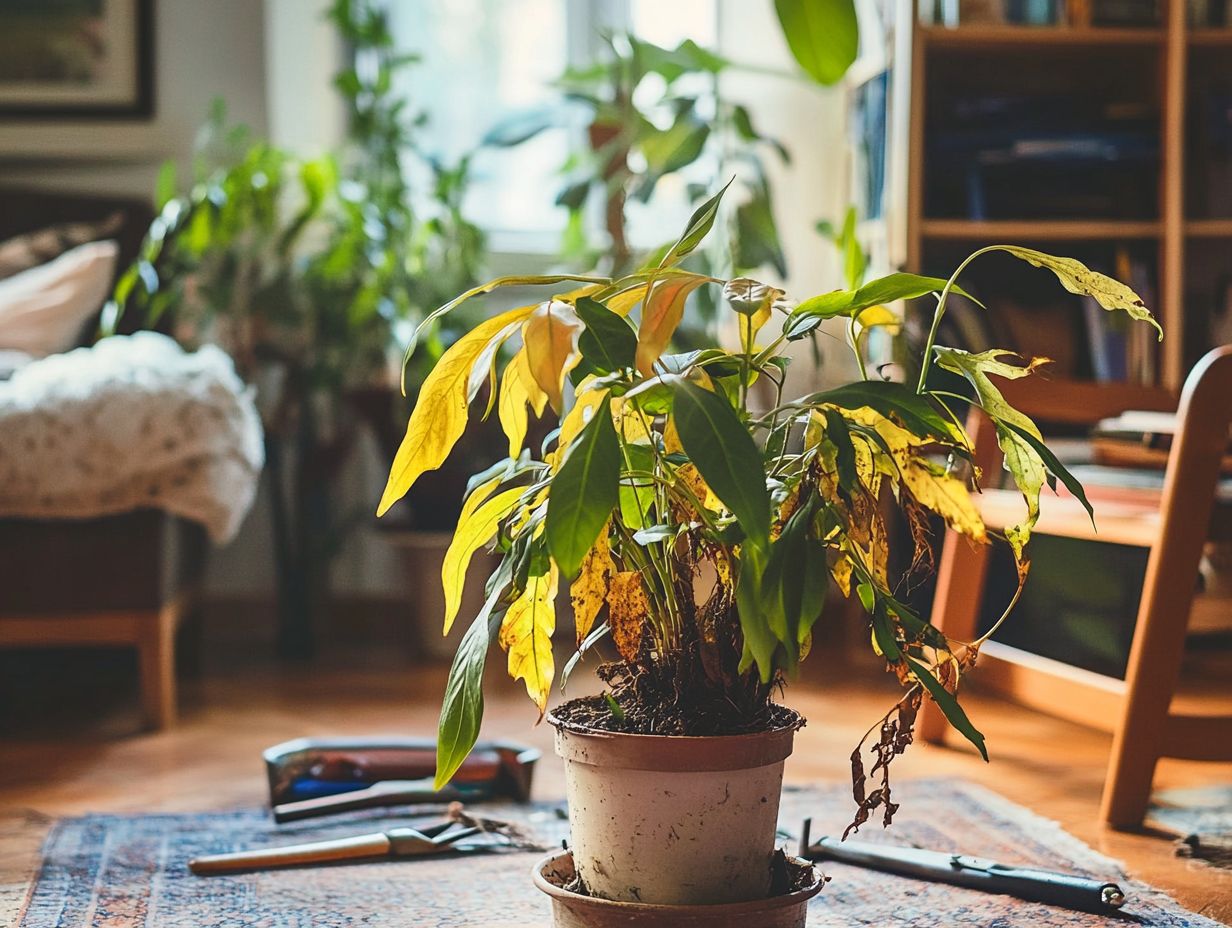
Some common signs include yellowing or wilting leaves, stunted growth, pests, and fungal growth.
When should I seek professional help for my indoor plants?
If your plants are showing severe or persistent problems, don t hesitate to call in the experts! This includes issues like widespread pest infestations, diseases, or damage to the plant’s structure.
How can I tell if my indoor plant problems are normal or not?
If you are unsure if your plant’s problems are normal, it’s always best to err on the side of caution and seek professional help. They can assess the situation and determine if any action needs to be taken.
Can I save my dying indoor plant on my own?
In some cases, you may be able to save your dying plant with proper research and care. However, if you are unsure of the cause of the problem or how to fix it, it s best to seek professional help to increase the chances of saving your plant.
What are some common mistakes that can lead to indoor plant problems?
Overwatering, underwatering, using the wrong type of soil, and placing plants in areas with insufficient light are all common mistakes that can lead to indoor plant problems.
Can indoor plant problems be prevented?
Yes, many indoor plant problems can be prevented by providing proper care and maintenance, such as regular watering, fertilizing, and monitoring for pests. It’s also important to research the specific needs of your plants and provide them with the right environment to thrive.
Take immediate steps to save your plants and share your experiences in the comments below!


